Wheatstone Bridge
| Curiously enough, the Wheatstone Bridge was not invented by
Charles Wheatstone (1802-1875), but by Hunter Christie. However, Wheatstone
was responsible for popularizing the arrangement of four resistors, a battery
and a galvanometer, and gave Christie full credit in his 1843 Bakerian Lecture.
Wheatstone called the circuit a "Differential Resistance Measurer."
And how to draw Wheatstone's Bridge? Wheatstone himself
used the familiar diamond pattern in his Needle
Telegraph; it has been suggested that his set of Blue Willow pattern
china, with the cross-hatching on the arched bridge forming part of its decorations,
suggested the shape to him.
The diamond-shaped Wheatstone bridge at the right,
from Hampden-Sydney College in Virginia, is by A. P. Gage of Boston.
|
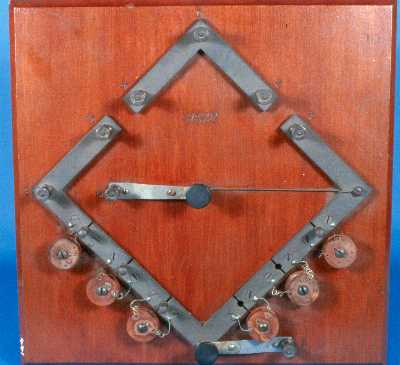
|
The slide wire form of Wheatstone's bridge was introduced
by Gustav Kirchhoff (1824-1887). The Leeds and Northrup Reversible Meter
Bridge below, in the Greenslade collection, is the Rolls Royce of slide wire
bridges, and is listed at $115.00 in the 1907 catalogue. The catalogue description
says, in part: "Base is of mahogany, strap connections of heavy copper,
all joints soldered and scale is engine divided on metal and plated. ...
The slider has both coarse and fine adjustments and is designed so that it
is impossible to cut or jam the wire. Vernier enables readings to be made
to 1/10 mm." The reversing switch in the middle has mercury contacts.

The more humble bridge below, in the Greenslade collection,
has a slide wire a half meter long. Seventy five years of use have worn away
the black markings on the white scale running the length of the apparatus.

This slide wire is in the apparatus collection of Antioch
University in Yellow Springs, Ohio. A brass plate tells us that it was built
by "A.E. Berdon, Y.S.,Oh." The workmanship is very fine. The arrangement of
conductors and the gaps across which resistances could be placed tell us
that it is a Wheatstone bridge, but it could also be used as a slide-wire
potentiometer.

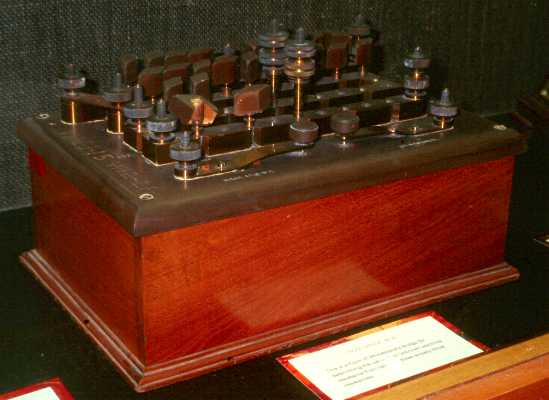
|
The Wheatstone Bridge that some of us remember is a
box of plugs like the one at the left at the Garland Collection of Classical
Physics Apparatus at Vanderbilt University.
The bridge is by James W. Queen of Philadelphia, and
is listed in the 1888 catalogue as "Set of Resistance coils, with bridge,
battery ken and Galvanometer key, old Post-office pattern, the wire of platinum
alloy ... $208.00."
In Great Britain, the telegraph system was controlled
by the Post Office, and hence the name "Post-Office Box" for the instrument
developed to make resistance measurements with the system.
|
| Leeds and Northrup of Philadelphia made an
array of Wheatstone bridges, some with plugs and some, like this one, with
dials and some plugs. The 1927 L&N catalogue of "Apparatus for Electrical
Resistance Measurements" lists this as an Open-Dial Wheatstone Bridge with
a price of $175. The metal parts are nickel-plated and the top is hard rubber.
The exposed studs serve as heat radiators, and holes in the side help to keep
the temperature of the coils constant.
This instrument is in the Greenslade Collection.
|
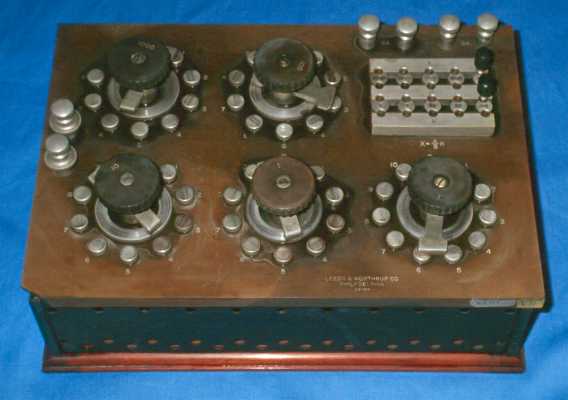
|
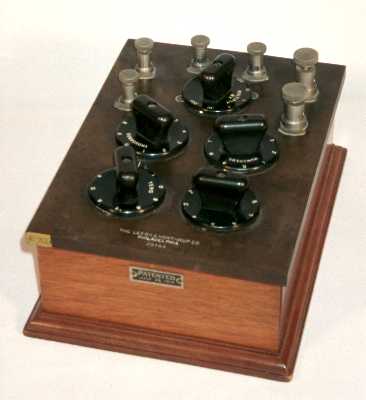
|
On the same page as the heavy-duty bridge above is the
Enclosed-Dial Wheatstone Bridge at the left. This was "very well suited for
use in laboratories and shops where gases and dirt would be likely to foul
exposed contacts. A multiplying dial gives seven ranges. The top is polished
hard rubber and the case polished mahogany. It bears a patent date of July
28, 1914.
The price was $55, and, since I have met numbers of
these instruments in my travels, it must have become a standard in undergraduate
electricity and magnetism laboratories.
This example is in the Greenslade Collection
|
| The small, unmarked device at the right in
in the apparatus collection of Grinnell College in Iowa.
It has the appearance of being a Wheatstone Bridge,
with one fixed resistance arm in the center, and a long slide wire that
may be tapped off at various points to obtain the resistance of two other
arms.
|
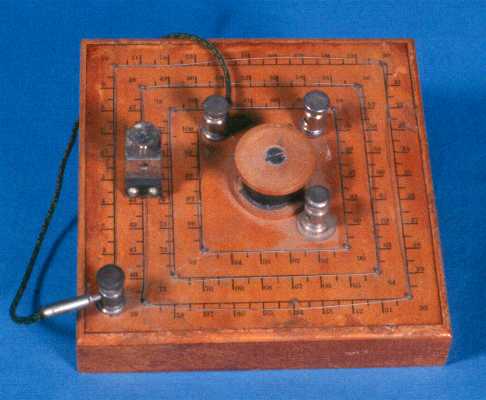
|
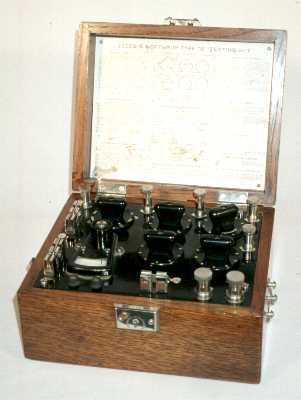
|
This portable test set by Leeds and Northup is in the Greenslade
Collection. Similar sets were made and sold by L&N for most of its careedr.
A later model was sold in 1950 for $140. I used sets like this in the introductory
laboratory for many years in an experiment to measure the temperature coefficient
of resistance of copper wire. |
| The Queen Acme Portable Testing Set at the left was adjusted
to 1/5 % precision at 20ºC on March 1, 1909. The galvanometer in the
lower left corner has been lost, and there are connections to an external
meter. The device is very much like early versions of the Leeds & Northrup
test set in the picture above. |
. 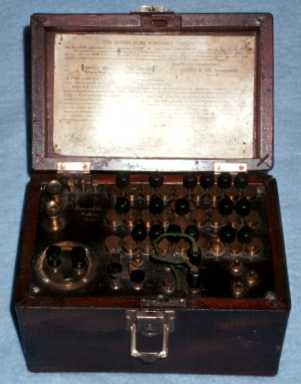
|
| The very large (and heavy!) Wheatstone Bridge
at the right was made by Otto Wolff of Berlin, probably in the nineteen twenties.
It has four rotating dials marked X.1, X1, X10 and X100, plus various ratio
dials.
The coils are made of Manganin, and it is started to
be "richtig bei 20ºC".
This lovely instrument was given to the Greenslade
Collection by Daniel Chaucer.
|
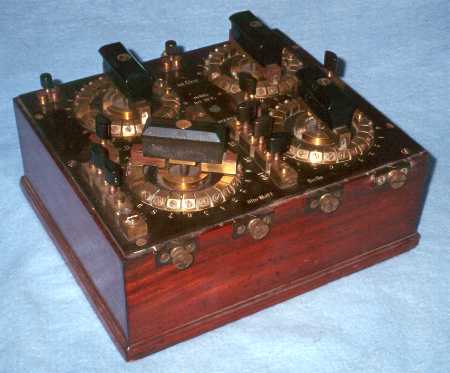
|
The bridge at the right is listed in the 1907 "Electrical Measuring
Instruments" catalogue of the Leeds & Northrup Company as "
"4470 DECADE BOX AND WHEATSTONE BRIDGE...$60.00
The rheostat coils are adjusted to an accuracy of 1/10th %. The rheostat
is on the improved decade plan... There are four decades and the values are
9(1 + 10 + 100 + 1000). The ratio coils are adjusted to an accuracy of 1/20th
%. They are 10,000, 1000, 100, 10, and 1. They are arranged on the improved
plan ..."
The instrument is in the Greenslade Collection.
|
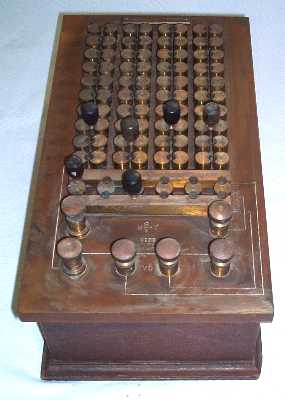
|
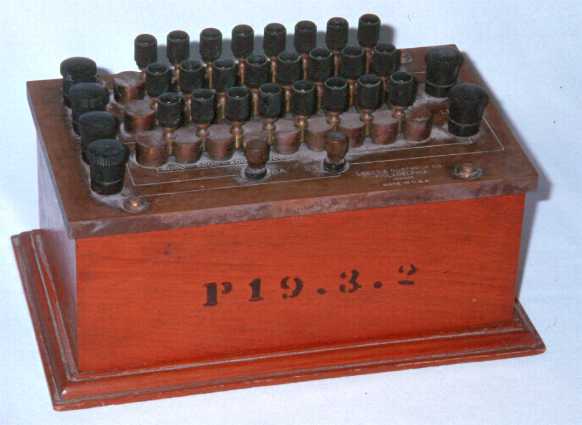
|
The Leeds & Northrup Model 4250 Wheatsone
Bridge at the left is a more modest version of the instrument above.
It is in the apparatus collection of Antioch University in Yellow
Springs, Ohio and its serial number suggests that it was made about 1930,
when it cost $60.
The appearance of the instrument shows the difficulty of making
site visits. The apparatus generally needs some gross cleaning, which is
quite difficult for a plug-type instrument. Next time I will carry an old
toothbrush to remove the dust from between the contact blocks.
|
REFERENCE: Thomas B. Greenslade, Jr., "Nineteenth Century Textbook Illustrations
(XXIII) The Rheostat", Phys. Teach., 16, 301-302 (1978)
Return
to Electrical Measurements Home Page | Return
to Home Page
